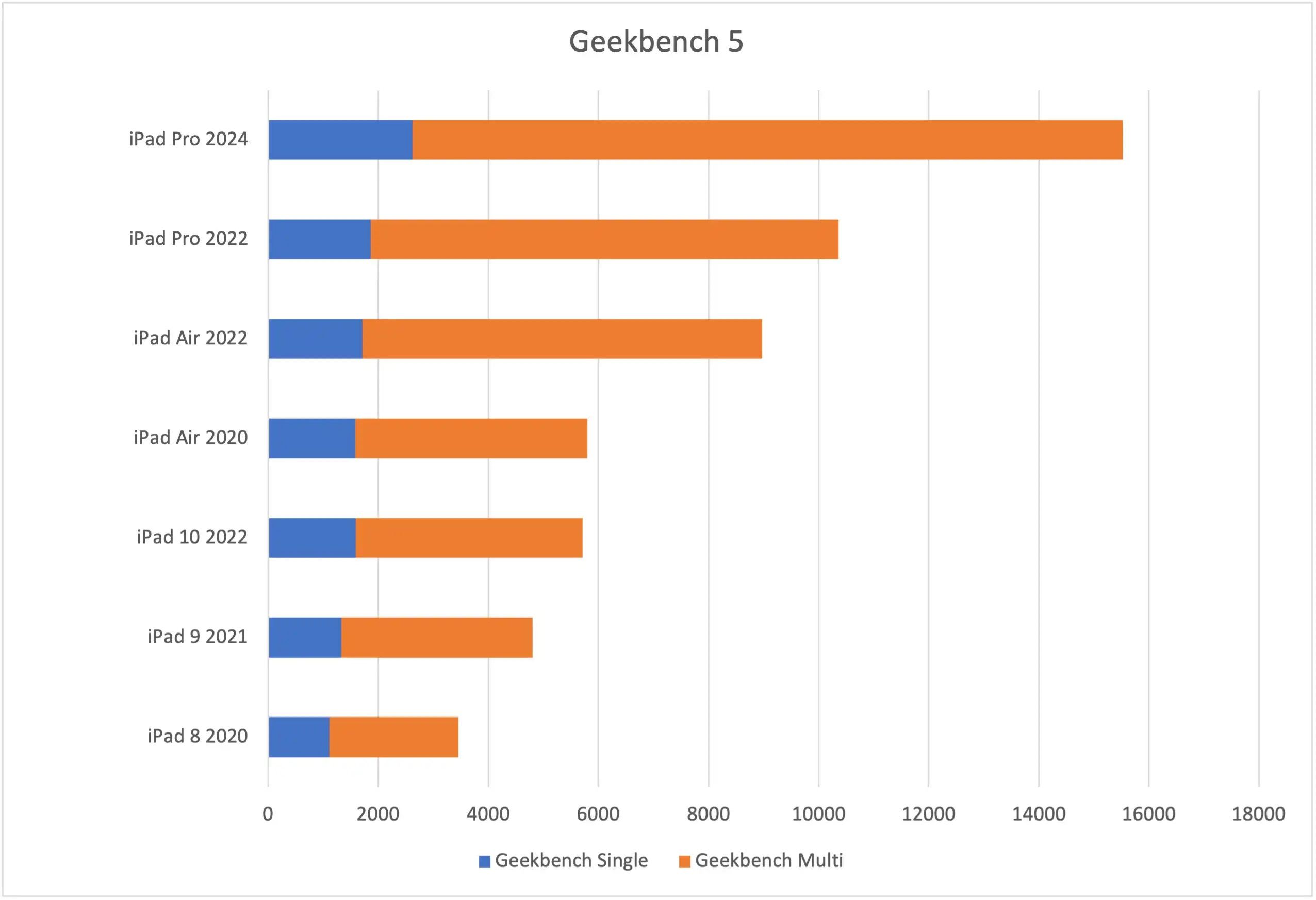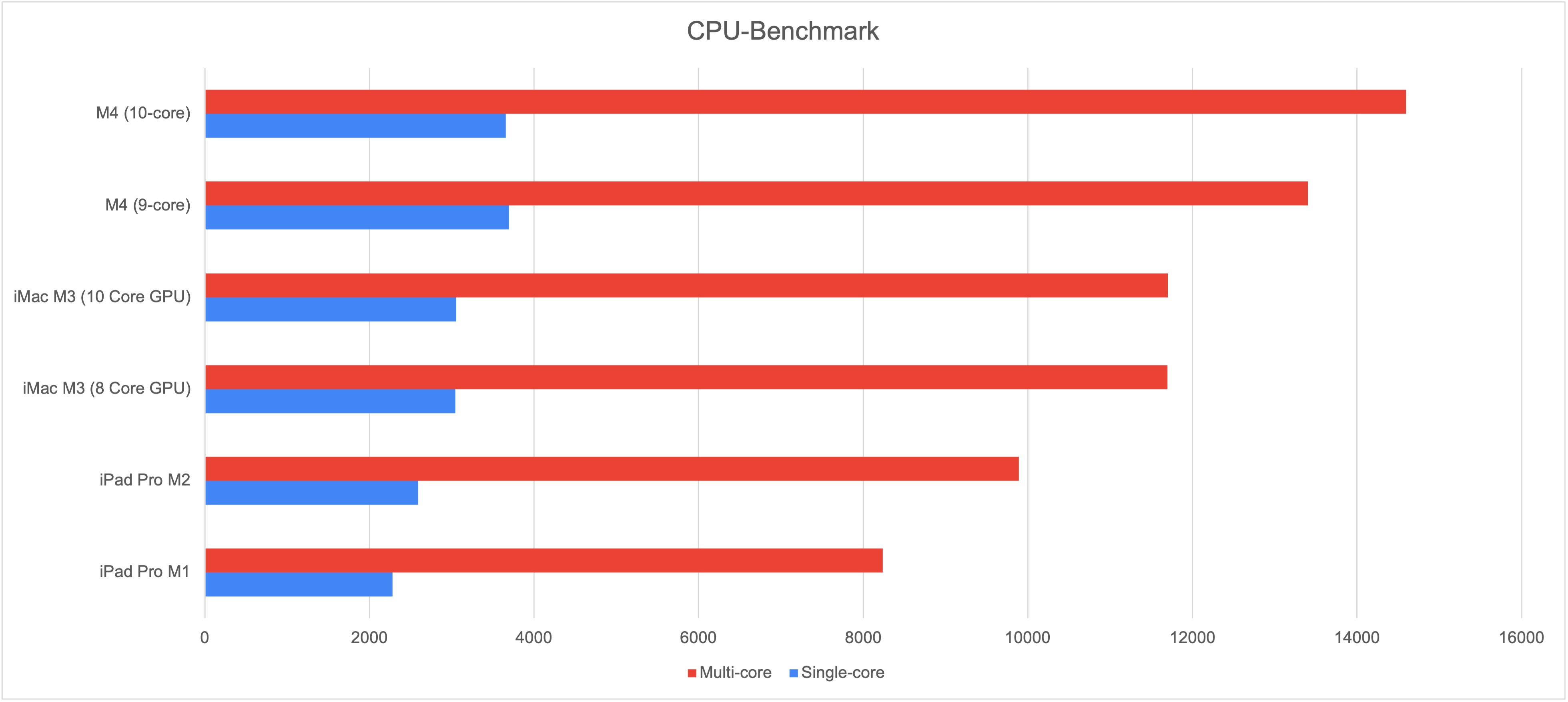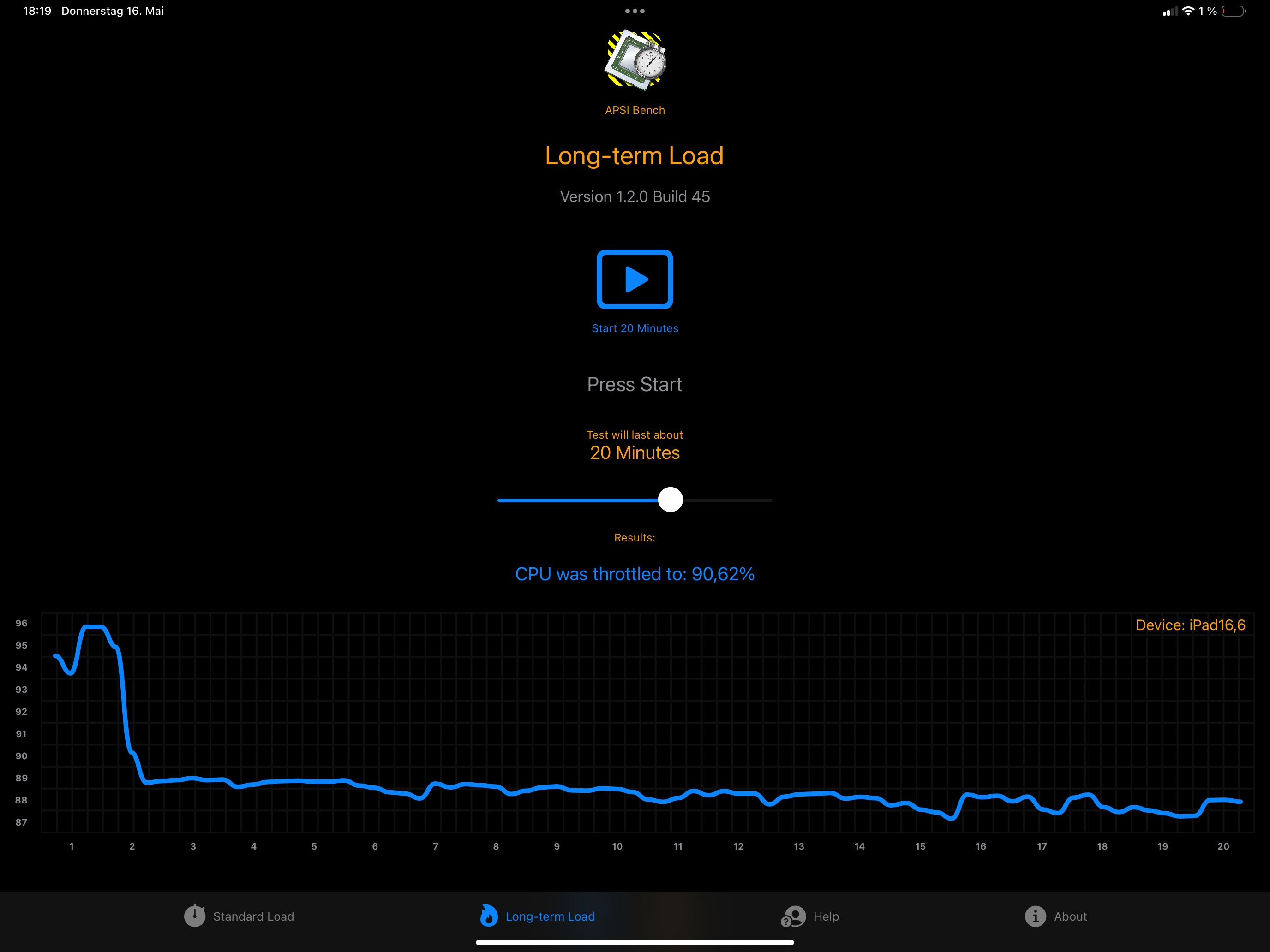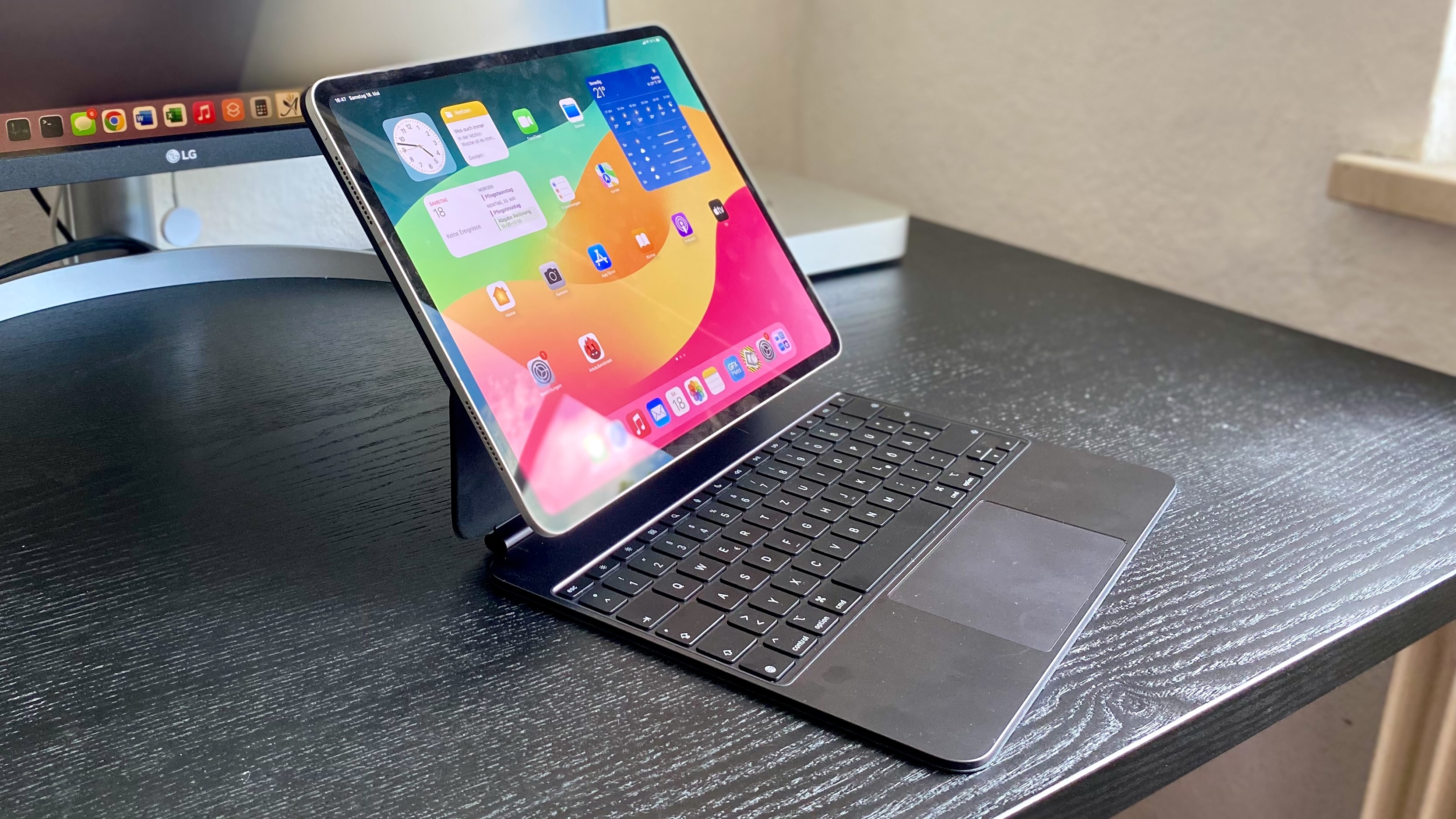Expert’s Rating
Pros
- First-class display
- Great performance
- Good battery life
- Thinner and lighter than its predecessor and the iPad Air
- Fast Thunderbolt and USB 4.0 interface
- Excellent keyboard cover
- Matt display as an option
Cons
- High price
- Old Magic Keyboard not compatible
Our Verdict
The new iPad Pro is the best tablet you can currently get. Its performance and range of functions are first-class, while the new OLED display saves on weight and makes a flatter chassis possible. The new Magic Keyboard is also a major highlight. However, the price is very high.
Best Prices Today: Apple iPad Pro 13-inch (M4, 2024)
$1,114
The iPad Pro offers a simple deal: pay more, and get the best possible performance and the widest range of functions. The new iPad Pro M4 also fulfills this promise. It is exclusively equipped with Apple’s most modern chip and offers an impressive OLED display with HDR support for the first time.
I don’t want to dwell on the question “Can an iPad replace a MacBook?” for long, as it’s been discussed far too often. (Many users long ago decided that it can.) Complaining about the high price is also pointless; it’s simply very expensive. The more interesting question is how much better the new iPad Pro is than its predecessor from 2022 and the new iPad Air, and whether it justifies that high price.
We can say without reservation that this is the best and fastest tablet we’ve ever tested and that the new keyboard is better than all previous Apple models. But for more details of our testing and evaluation, read on.
M4 iPad Pro: Design and build quality
Since 2018, the iPad Pro has impressed with an attractive, if rather angular design. Visually, little has changed here, even if the tablet is now available in Space Black instead of Space Gray. (This was a moot point for us since we were sent the silver version for our review.)
Thanks to the flatter OLED display, Apple was able to make the devices around 1mm thinner for this generation: the 13-inch model is now only 5.1 mm thick instead of 6.4 mm, while the 11-inch model has dropped from 5.9mm to 5.3mm. The lower weight of 579g/444g is also pleasing; the predecessors weighed 682g and 466g respectively. This makes the 13-inch model in particular handier and more elegant. Another new feature is the missing SIM slot. If you use the 5G model, mobile communications will only work via an eSIM, which contributes to the thinness.
Unfortunately, the design change means that many older protective cases are no longer suitable, and the old Magic Keyboard no longer fits precisely. A charger is no longer included in the flat box, only a USB-C cable. Although Apple justifies this on environmental grounds, I still find this a bit silly for a device costing so much.
M4 iPad Pro: Processor and specs
Surprisingly, Apple has installed a completely new processor chip, the M4, in the new iPads. This has never appeared in any Apple products before now: not an iPad, an iPhone, or even a Mac. (We’ve got a separate article where you can read more about the specs and features of the M4.)
By contrast, the M3 chip is used in the recently launched MacBook Air, while the Mac mini and the new iPad Air still use the M2 we saw in the iPad Pro from 2022. Note, however, that there are some variations here; Apple is using an M2 chip with only 9 GPU cores in the iPad Air 2024, whereas the old iPad Pro M2 had a chip with 10 cores.
Apple probably had good reasons for this leap forward on the Pro while other machines remain on older silicon. It’s likely that Apple’s chip manufacturer TSMC cannot produce many of these new chips at the moment, while some of its strengths make it the perfect choice for the iPad Pro.
Thanks to the new N3E node manufacturing process, for example, it offers better efficiency than M2 and M3; in other words, more performance per watt. In the now slightly thinner chassis of the iPad Pro, this is a major advantage over the M3 and M2. In addition, the iPad Pro allegedly requires a particularly powerful display engine due to the two-layer OLED display, which the M4 offers.
A fast Neural Engine with sixteen cores should also make the iPad suitable for future AI functions and apps. Last but not least, Apple probably wants to keep competitors such as the Microsoft Surface Pro–which relies on AI and Snapdragon X–at a distance.
Class-leading performance
As expected, results in our benchmarking suite were excellent; Geekbench testing revealed clear improvements in CPU performance compared to the M3. However, Apple would prefer us to compare the M4 chip with the M2, which is found in the new iPad Air and iPad Pro 2022. The company promises that the M4 will deliver one and a half times the CPU performance of the M2, and four times its graphics performance. Our testing confirmed this.
The only devices that come anywhere even slightly close to the M4 Pro right now are iPads with an M1 or M2 chip. iPhones and the 10th-gen iPad are a long way behind, as are all tablets from the Android camp.
As promised, graphics performance is also very impressive, as revealed in the Wildlife Extreme benchmark. The iPad Pro M4 scored a superb 8,516 points, beating even the MacBook Pro M3 (which scored 8,030). In our Solar Bay test the Pro scored an excellent 14,771 points, whereas the iPad Pro M2 managed only 8,787.
With a fanless device like this, heat dissipation can be an issue, but Apple says the new iPad Pro is 20 percent faster at this than its predecessor. The Apple logo is made of copper, while graphite plates in the housing ensure better heat dissipation.
The gap to the older iPads is large.
Foundry
The iPad is also superb in terms of continuous performance. The new 13-inch iPad Pro can deliver its high performance for a long time, with the so-called throttling effect–that’s to say, throttling of performance to keep heat under control–only slightly noticeable. In the APSI Long-term Load test, performance dropped only to 90.62 percent, an outstanding effort. The heat dissipation evidently works well.
IDG
GPU performance.
IDG
In the Wild Life Extreme Stress Test, the graphics cores are put under strain for 20 minutes instead of the CPU. Here, graphics performance dropped to 79.5 percent: also an excellent value. Scores of 31.187 in the Manhattan Offscreen test and 2,746,026 in Antutu confirmed our good impressions of the Pro M4’s capabilities.
The tablet also shone in our browser benchmarks, achieving 339,631 in the JetStream test and 44.8ms in SunSpider.
Even under continuous load, CPU performance dips only slightly.
IDG
It’s important to remember that Apple uses two versions of the M4 chip. New iPad Pro models with 256GB or 512GB capacity contain a version with nine instead of 10 CPU cores and only 8GB instead of 16GB RAM. In view of the high performance of the M4 chip, however, this should hardly be noticeable in practice; in the most demanding, processor-intensive contexts only. For our testing, Apple provided us with a 1TB (and 5G) unit, which therefore has 10 CPU cores and 16GB of RAM. The benchmark figures above apply to this model.
High performance is not only guaranteed by the CPU and GPU: the Neural Engine, which is important for AI, has also been improved and the Media Engine of the M4 iPad supports the professional video format ProRes, for example, which makes playing and editing such videos much easier. The AV1 codec is also supported. The iPad Air does not offer this.
Like the M3, the M4 also supports ray tracing, which ensures better image quality and lighting effects in current games such as Diablo Immortal and Resident Evil 5, and upcoming games such as Assassin’s Creed Mirage. For mobile gaming, the Pro is clearly superior to the Air.
Whether the iPad Pro really needs this performance is debatable. However, it is not foreseeable what requirements future apps in the areas of VR/AR and AI will bring. With an iPad Pro, you have little to fear in terms of future-proofing.
Super-fast USB-C
The Pro models are also known for their fast USB-C interfaces, which we tested using an external SSD.
A fast LaCie Rugged SSD was recognized immediately and we transferred a 13.1GB test file over USB-C. We measured a maximum transfer rate of 2,220MB/s when transferring to the iPad and 1,578MB/s when copying to the SSD: both excellent values for an iPad. (The 10th-gen iPad, which also has a USB-C port but offers a slower connection, managed just under 40MB/s in this test.)
The internal memory of the iPad is also very fast. Using the Jazz Disk app we measured speeds of 3,362MB/s and 2,017MB/s for reading and writing respectively.
M4 iPad Pro: Magic Keyboard
Since the Magic Keyboard introduced in 2022 is unfortunately no longer compatible, the new iPad Pro is accompanied by an exclusive new keyboard. The model now called Magic Keyboard for iPad Pro (M4) can be recognized by its metal inner surface, which strongly resembles a current MacBook Air. You can choose between the colors white and black. the 11-inch version costs $299, the 13-inch version $349.
I was impressed by the keyboard for the 13-inch model (we didn’t test the narrower 11-inch version) which feels like a good notebook keyboard when typing texts and navigating using keyboard commands.
The new keyboard cover works perfectly.
IDG
There’s been a large and obvious jump in quality from older iPad keyboard cases to this. I took out my old Smart Keyboard for comparison, and it looks almost shabby next to the smart new Magic Keyboard, while the feel of its typing is several classes worse.
The aluminum on the inside feels very high-quality, and the new bar with fourteen function keys is a welcome improvement. And while the predecessor already had a trackpad, Apple has improved this input option. It’s now made of glass and works much more precisely and reliably than the one on the previous model.
Unlike a smooth MacBook, the 658g case is rubberized. This makes a lot of sense, as it gives the iPad a much better grip and prevents it from slipping out of the hand so easily. However, this surface is unfortunately also more susceptible to dirt than the aluminum of a MacBook, and the black cover seems to magically attract dust. And there’s one thing I had to get used to: opening the cover felt a bit wrong at first. This is because the top is thicker and heavier than the bottom and there is no notch to grab.
Is the Magic Keyboard too expensive for you? Logitech’s Combo Touch is one alternative, but at $260, the 13-inch model is no real bargain either. Furthermore, according to Logitech, it’s apparently not suitable for the model with nano-textured glass. It’s possible that these display variants are too sensitive or the material is too hard.
M4 iPad Pro: Apple Pencil Pro
The Pencil Pro is completely new, and offers a new tilt sensor that provides more creative usage options. Also new: you can call up functions by squeezing the pen, such as a palette in the Procreate drawing app.
However, I don’t think that a Pencil is obligatory or useful for every iPad owner. Not even the more expensive Pro version.
M4 iPad Pro: OLED Display
The crucial change in the screen department is that OLED is now being used for the first time instead of an IPS panel. This is a good decision. The screen has a better contrast and black levels, and it’s better at displaying HDR content (such as Apple TV+ films).
OLED displays are considered superior for mobile devices as they are flatter and likely to consume less power. If you use dark mode with lots of black areas, for example, the OLED display can simply switch off the corresponding pixels and save power. This effect was noticeable in our battery test.
Furthermore, thanks to the use of a so-called Tandem OLED display, the screen is able to achieve a very high brightness of 1,000 nits. Brightness was previously a weakness of OLED displays.
Video fans will be pleased to hear about support for Dolby Vision, HDR10, and HGL (as will creative professionals who produce such videos) as HDR displays can even reach up to 1,600 nits. Streaming fans should not underestimate this either; my impression is that more and more Netflix series are being optimized for HDR displays. Blooming, when you see blurred edges on objects, also does not occur. This was a point of criticism with the mini LED displays of the previous Pro.
Another new screen option was met with great enthusiasm at the product launch. Provided you buy a model with at least 1TB of storage, you can choose to get a version with nano-textured glass, which is less reflective. And one thing is certain: if you use the dark mode, which in most respects is ideal for OLEDs, the reflections can be quite annoying in the long run. However, bear in mind that the nano-textured screens are more vulnerable to scratch damage. The YouTuber JerryRigEverything, known for his scratch resistance tests, reports that on a scale of one to ten (based on the Mohs hardness standard), scratches occur at level four for the nano-textured screen, whereas the traditional model only starts to suffer scratches at level six.
Another advantage over the 13-inch iPad Air is the ProMotion function. The system can dynamically adjust the refresh rate between 10 and 120Hz to ensure smooth screen output, while saving battery power when higher rates are not required. In general there was little to criticize in terms of color reproduction, which is somewhat warmer that on older Pro models, although we did notice a few color errors on some HDR content. Apple has said it’s working on a software update to rectify this issue.
For color-critical tasks, there is a “reference mode” in which the iPad uses reference colors for common color standards and video formats. In this mode, disruptive color adjustments such as Night Shift and True Tone are automatically switched off. Calibration with an external device is also possible.
For technical reasons, the OLED display is not completely free from PWM (pulse-width modulation), a flickering that can cause headaches and eye problems for a few users. However, the effect is very slight on this device and should bother very few users.
M4 iPad Pro: Camera
The camera and sensor setup is one of the areas where Apple’s Pro models differentiate themself from the cheaper lines. They’re the only iPads to get LiDAR scanners and Face ID, for example.
There’s little new to report about the rear-facing camera. Since 2018, iPad Pros have all had a wide-angle camera with a decent (f/1.8) sensor and 12MP resolution, capable of recording videos up to 4K and 60fps. In fact we’ve lost something for this generation: the ultra-wide-angle lens that’s sat on the rear since 2020. This was apparently quite popular with architects and craftsmen, and it’s a shame to see it go.
One new feature is that the flash has been optimized for scanning documents. Several shots are now automatically combined when scanning, which improves the image quality and avoids unwanted shadows.
Pleasingly, the front camera is now more suitable for video chats because Apple has moved it to the long right-hand edge of the screen. (This change was first made on the 10th-gen iPad in 2022, and this year comes to the Air and Pro models.) This provides a more natural viewing angle during video conferences, as almost everyone props up their iPad on its side, likely in a holder or keyboard case, for such situations.
Based on early impressions, the front camera doesn’t deliver a noticeably better picture than you get with other iPads. Image quality can also be affected by poor lighting conditions. However, thanks to digital zoom and the Center Stage feature, you always remain automatically in the picture during video calls. By tapping a small arrow icon on the left-hand side, you can activate the native wide-angle mode and show a much wider viewing angle, for example to show the whole office or the whole family.
Should you pick the 11-inch or 13-inch model?
As impressive as I find the 13-inch iPad Pro, the form factor has disadvantages for a tablet. In everyday use, it’s significantly heavier and more unwieldy than an 11-inch model. If you’re watching a longer video, you’ll find you want to put it down somewhere because of the weight. The 11-inch model is therefore probably ideal for most home users.
The larger screen makes sense, however, if you use your iPad a lot in landscape mode, for example with a keyboard case. The larger screen is also valuable if you use it for professional tasks such as film editing and image processing.
Apple iPad Pro 11-inch (M4, 2024)
M4 iPad Pro: Battery life
The 13-inch iPad Pro is powered by a large battery specced at 10,210mAh or 38.99 watt-hours, while the 11-inch model is rated at 31.29 watt-hours. Despite this disparity, Apple makes the same claim for battery life for the two devices: 10 hours of web browsing or video playback. Our benchmarks support this, with our review unit even exceeding Apple’s estimate for video playback.
For this test, we put a TV episode on a continuous loop. And the results were outstanding: a full 14 hours of video at full brightness. Battery performance was also good when surfing the web, at just under ten hours.
There is one important factor that we should point out. With an LCD display, it doesn’t really matter what content is playing; the energy consumption depends quite straightforwardly on the device’s brightness setting. With an OLED, on the other hand, the black levels of the content showing on the screen are a decisive factor. A dark Scandinavian detective drama puts far less strain on the battery than a bright summery comedy. You can also significantly increase battery performance when surfing the web and working with apps by activating dark mode. Nevertheless, regardless of the dark/light factor, the iPad Pro should be able to manage a full working day of normal activities.
But how do we define ‘normal’ activities? Well, that depends on how much you want to push that super-fast M4 chip. At maximum CPU and graphics performance, the battery drains much faster than on an iPad with a slow CPU. In the 3DMark Wild Life Extreme stress test, battery levels dropped by 20 points after 20 minutes of maximum load. So playing very demanding games or running exceptionally high-end apps may result in a battery life that’s considerably below the 10-hour mark.
On the positive side, the iPad Pro models can be charged faster than their cheaper siblings. If you can get your hands on a 40W power supply, a full charge is possible in two hours. With a 20W unit, it takes almost three.
Note that charging speeds are not consistent across the full 100-point spectrum. After just 15 minutes with a powerful charger, you should have reached around 15 percent capacity, and that rate continues up to around 75 percent. From that point, however, charging slows down to conserve the battery’s long-term health. After 100 minutes, we’d only got to 86 percent, and it took another half an hour or so before the device was fully charged.
Incidentally, Apple has expanded the battery settings page on the new Pro models a little, enabling you to see the number of charging cycles and the battery’s year of production for the first time. Here you can also limit the maximum charge to 80 percent to protect the battery.
Should you buy the M4 iPad Pro?
The iPad Pro is impressive, and for all of Apple’s creative-focused advertising, you don’t have to be a film producer or artist to enjoy it. The majority use their Pro for Netflix, photos, and emails, and as a work device for Outlook, Excel, and Word. The iPad Pro M4 is expensive, but it’s simply the best tablet on the market right now. It’s fun to work with, and many people are quite rightly prepared to pay a little more for it.
| Model | 11-inch iPad Pro (M4) | 13-inch iPad Pro (M4) |
|---|---|---|
| Price (base Wi-Fi model) | $999/£999 | $1,299/£1,299 |
| Price (base cellular model) | $1,199/£1,199 | $1,499/£1,499 |
| Display | 11-inch Ultra Retina XDR, ProMotion technology | 13-inch Ultra Retina XDR, ProMotion technology |
| Resolution | 2420 x 1688 (264ppi) | 2752 x 2064 (264ppi) |
| Display technology | Tandem OLED, fully laminated display, anti-reflective coating | Tandem OLED, fully laminated display, anti-reflective coating |
| Color space | Wide color gamut (P3), True Tone | Wide color gamut (P3), True Tone |
| Brightness | 1.000 nits; HDR 1,600 nits | 1.000 nits; HDR 1,600 nits |
| Processor | Apple M4 | Apple M4 |
| CPU (256GB/512GB) | 9-core CPU with 3 performance cores and 6 efficiency cores | 9-core CPU with 3 performance cores and 6 efficiency cores |
| CPU (1TB/2TB) | 10-core CPU with 4 performance cores and 6 efficiency cores | 10-core CPU with 4 performance cores and 6 efficiency cores |
| Graphics | 10-core GPU | 10-core GPU |
| Neural Engine | 16-core | 16-Core |
| Media Engine | Hardware accelerated 8K H.264, HEVC, ProRes and ProRes RAW, AV1 decoding | Hardware accelerated 8K H.264, HEVC, ProRes and ProRes RAW, AV1 decoding |
| RAM | 8GB (256GB/512GB models); 16GB (1TB/2TB) | 8GB (256GB/512GB models); 16GB (1TB/2TB) |
| Storage capacity | 256GB/512GB/1TB/2TB | 256GB/512GB/1TB/2TB |
| Rear camera | Wide-angle 12 MP, f/1.8 | Wide-angle 12 MP, f/1.8 |
| Front camera | 12 MP landscape format ultra wide-angle front camera, f/2.4 | 12 MP landscape format ultra wide-angle front camera, f/2.4 |
| Speakers, microphones | 4 speakers, 4 microphones | 4 speakers, 4 microphones |
| Sensors | Face ID; LiDAR scanner | Face ID; LiDAR scanner |
| Connectors | Thunderbolt/USB 4; Smart Connector | Thunderbolt/USB 4; Smart Connector |
| Pencil (optional) | Apple Pencil Pro, Apple Pencil (USB) | Apple Pencil Pro, Apple Pencil (USB) |
| Wi-Fi | WLAN 6E (802.11ax) with 2×2 MIMO | Wi-Fi 6E (802.11ax) with 2×2 MIMO |
| Bluetooth | 5.3 | 5.3 |
| Mobile data | 5G/LTE/UMTS/HSDPA | 5G/LTE/UMTS/HSDPA |
| SIM card | eSIM | eSIM |
| Colors | Silver, Space Black | Silver, Space Black |
| Battery | Lithium polymer, 31.29Wh | Lithium polymer, 38.99Wh |
| Estimated battery life (browsing Wi-Fi) | 10 hours | 10 hours |
| Estimated battery life (browsing cellular) | 9 hours | 9 hours |
| Dimensions (W/H/D) | 177.5 x 249.7 x 5.3mm | 215.5 x 281.6 x 5.1mm |
| Weight | 0.98 pounds/444g (Wi-Fi); 0.98 pounds/446g (cellular) | 1.28 pounds/579g (Wi-Fi); 1.28 pounds/582g (cellular) |
This article originally appeared on our sister publication Macwelt and was translated and localized from German.
Source : Macworld














